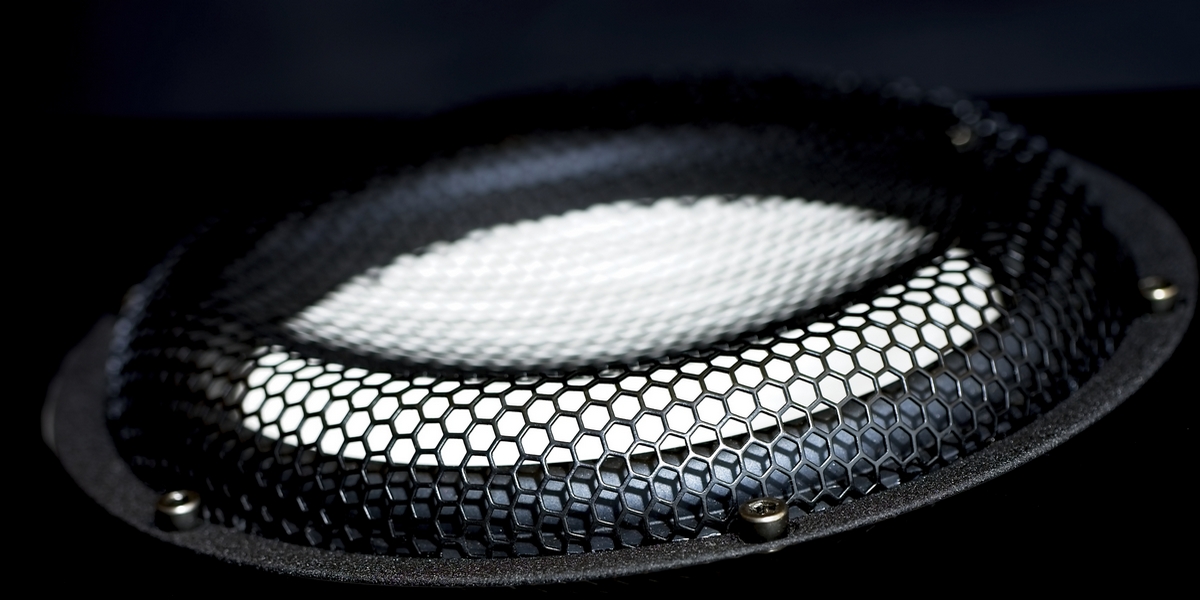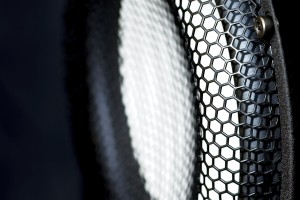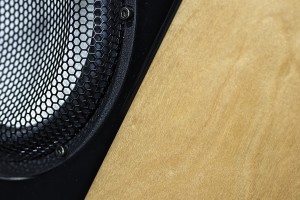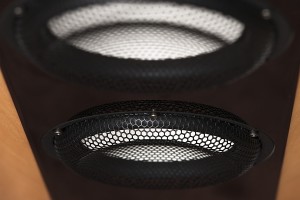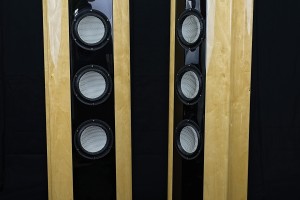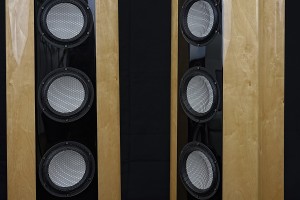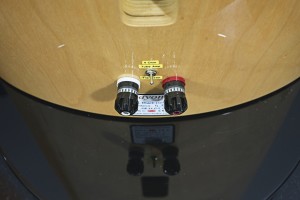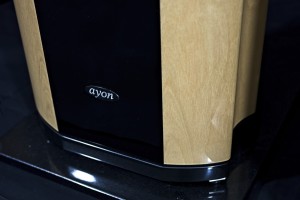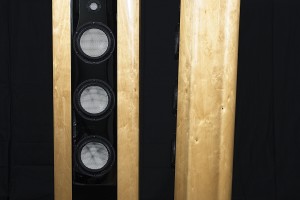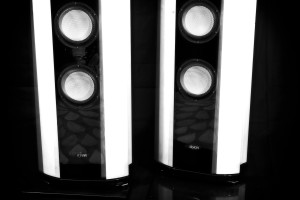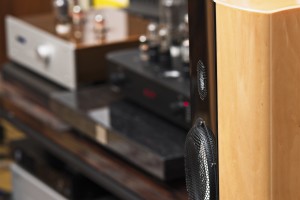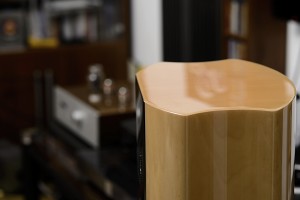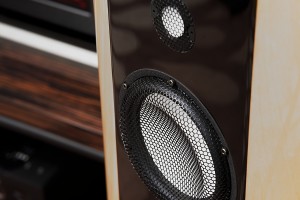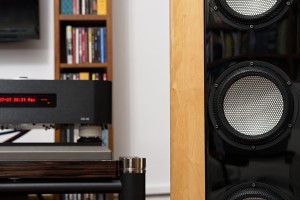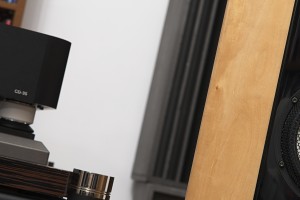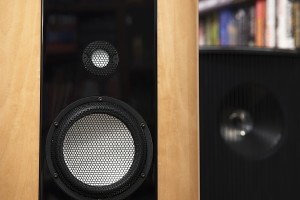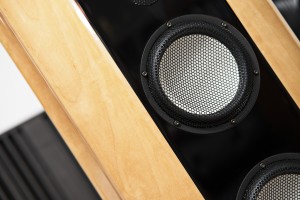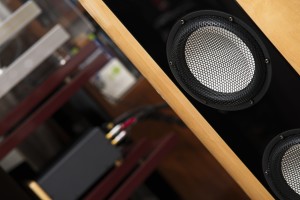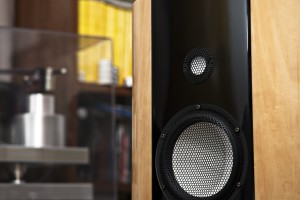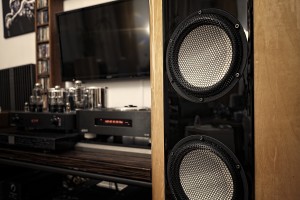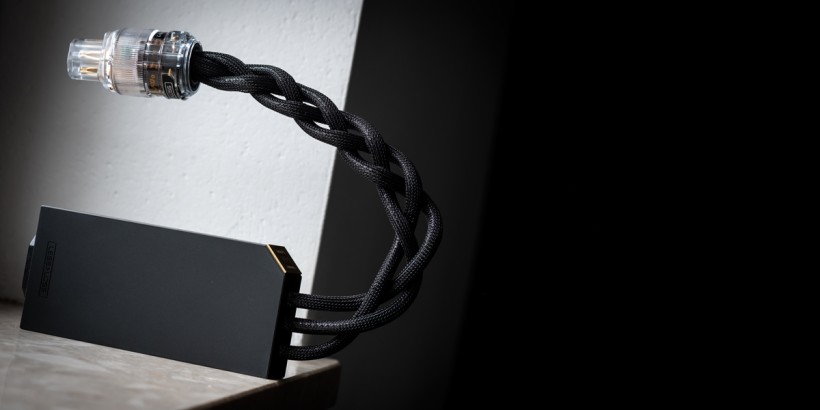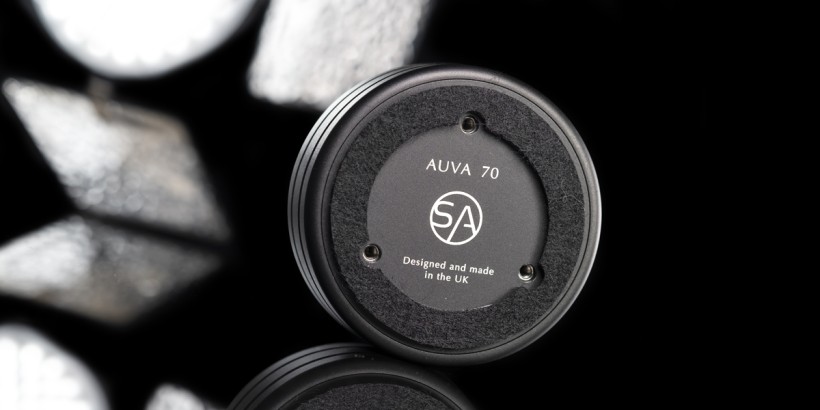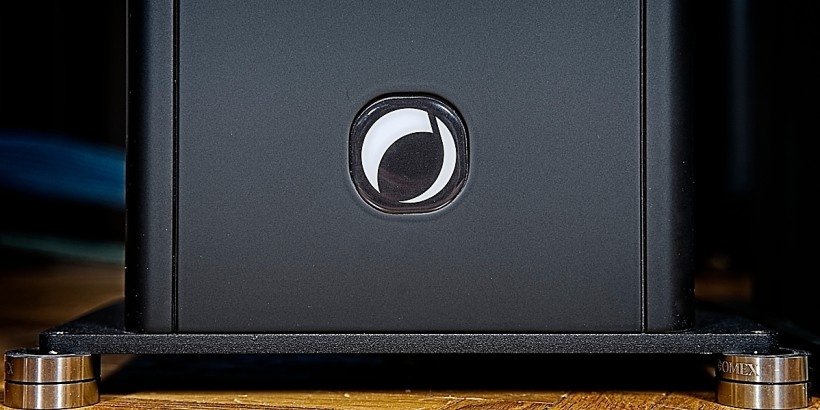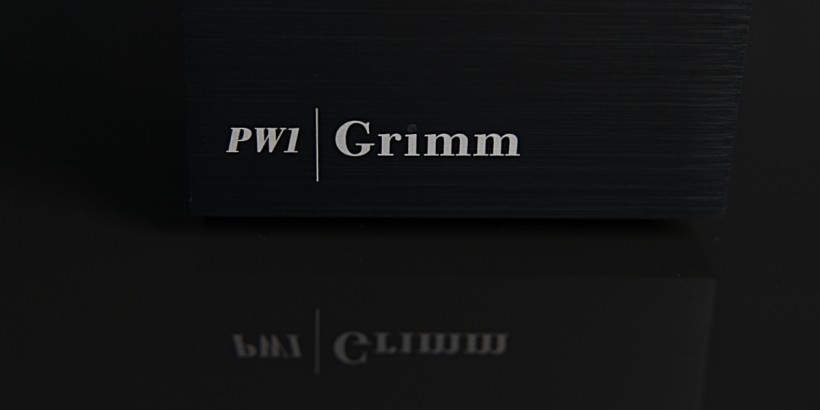Ayon Audio brand needs no introduction as it’s been highly valued by audiophiles and music lovers around the world for many years. The best known are their electronic components – the excellent, beautifully natural sounding tube amplifiers and preamplifiers, CD / SACD and network players. Slightly less known though, are their speakers but the brand’s fans know that Ayon has been manufacturing them for over 15 years. For this review we received the smallest model of the lineup renewed in 2018, the Ayon Audio BlackHeron.
Introduction
The idea of this review came up during the last Audio Video Show in Warsaw, when Gerhard Hirt, the man behind Ayon Audio, with his inherently high level of natural energy (despite the fact that it was actually the end of the second day of the Show and he could have been already quite tired), told me all about his new loudspeakers. During the conversation he emphasized that despite the fact that in some respects, such as use of similar drivers, the speakers may seem similar to earlier models, the changes were actually quite significant. The development has taken quite a long time, and the goal was clear – to create even better sounding loudspeakers featuring ceramic drivers (which should not be surprising considering that Gerhard is also behind the Lumin White brand and also earlier Ayon models had featured this type of drivers) with high efficiency and an impedance curve that would make them suitable partners for tube amplifiers. 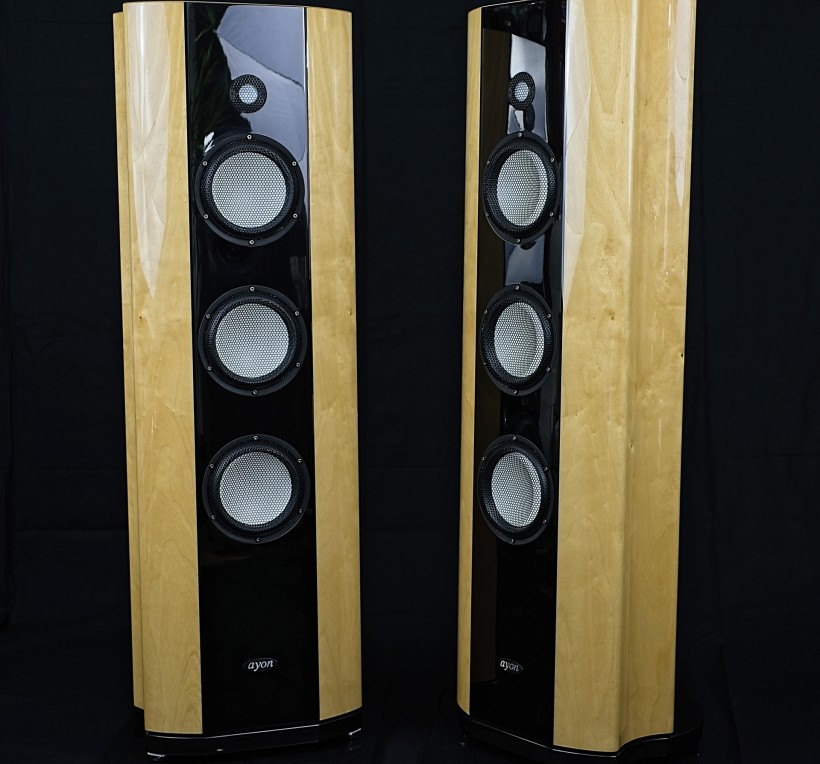 Actually, the idea was to develop versatile speakers, not ones that would play well only with tube amplifiers. Therefore, you can find a small flip switch on the rear panel of all new models. The reviewed BlackHeron model also features one with two positions described as: transistor and 4Ω tube (nominal impedance is the same regardless of the position of the switch, but in the case of tube amplifiers it is much more important). And other models feature similar, although even more advanced solution. The difference between one switch position and the other does not rely on simple impedance linearization (for the tube amps), which some companies apply in their speakers. As Gerhard explained during the conversation, a proper cooperation of a tube amplifier with speakers is quite a complex issue. Taking advantage of many years of experience and having a full range of excellent tube amplifiers at hand, Ayon engineers developed appropriate solutions to make the new speakers models work perfectly with tube amplifiers. As already mentioned, the company did not want to limit a pool of potential buyers for their loudspeakers to the tube lovers (even if Ayon tube amps are the logical first choice). Therefore, crossovers are designed so that after flipping said switch to the position marked as “transistor” the speakers operate optimally with solid-state amps. In cheaper models, also the BlackHeron, these solutions are a bit simplified, but they have to effectively fulfill the same role.
Actually, the idea was to develop versatile speakers, not ones that would play well only with tube amplifiers. Therefore, you can find a small flip switch on the rear panel of all new models. The reviewed BlackHeron model also features one with two positions described as: transistor and 4Ω tube (nominal impedance is the same regardless of the position of the switch, but in the case of tube amplifiers it is much more important). And other models feature similar, although even more advanced solution. The difference between one switch position and the other does not rely on simple impedance linearization (for the tube amps), which some companies apply in their speakers. As Gerhard explained during the conversation, a proper cooperation of a tube amplifier with speakers is quite a complex issue. Taking advantage of many years of experience and having a full range of excellent tube amplifiers at hand, Ayon engineers developed appropriate solutions to make the new speakers models work perfectly with tube amplifiers. As already mentioned, the company did not want to limit a pool of potential buyers for their loudspeakers to the tube lovers (even if Ayon tube amps are the logical first choice). Therefore, crossovers are designed so that after flipping said switch to the position marked as “transistor” the speakers operate optimally with solid-state amps. In cheaper models, also the BlackHeron, these solutions are a bit simplified, but they have to effectively fulfill the same role.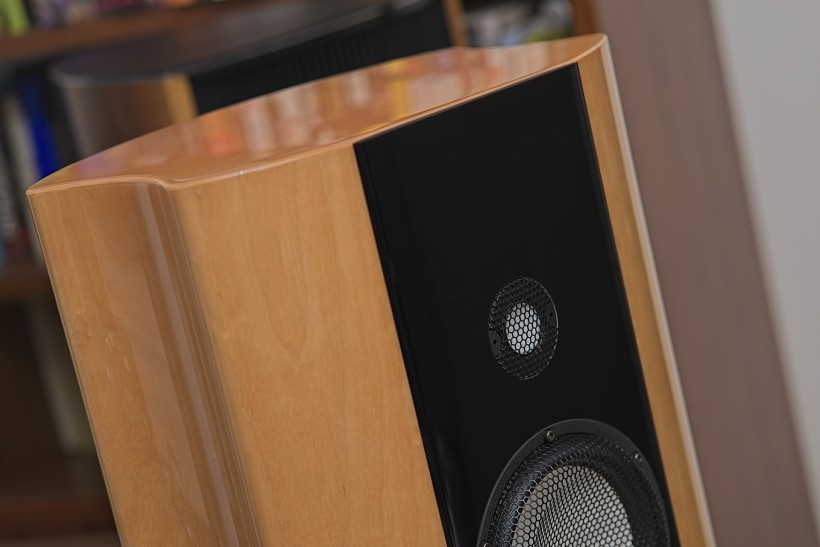 The system presented at the AVS in Warsaw featured the top model from the new series, the BlackCrane. Judging by the reactions of the large audience, vast majority, if not all the people liked their sound at least as much as yours truly. Obviously the applauded performance came from a complete Ayon system, not just the speakers. I knew I wanted to check new Ayon products in my system. From the very beginning it was clear that the BlackCrane was too big a model for me, i.e. for my room to carry out a reasonable test. Fortunately, in the corner of the same room, I spotted a single clearly smaller speaker – the “BlackHeron”, which seemed definitely more suitable for my needs. I am not a huge fan of ceramic drivers to be honest, but first of all I’m always interested in loudspeakers suitable for tube amplifiers. Secondly, I had an opportunity to test one of the older Ayon speakers, which proved again that in case of drivers their application (or in other words the knowledge and experience of the designers) is much more important than what the membrane is made of. This fact, plus the experience with most products from the Austrian company’s lineup assured me that it was worth getting acquainted with the new Gerhard’s product.
The system presented at the AVS in Warsaw featured the top model from the new series, the BlackCrane. Judging by the reactions of the large audience, vast majority, if not all the people liked their sound at least as much as yours truly. Obviously the applauded performance came from a complete Ayon system, not just the speakers. I knew I wanted to check new Ayon products in my system. From the very beginning it was clear that the BlackCrane was too big a model for me, i.e. for my room to carry out a reasonable test. Fortunately, in the corner of the same room, I spotted a single clearly smaller speaker – the “BlackHeron”, which seemed definitely more suitable for my needs. I am not a huge fan of ceramic drivers to be honest, but first of all I’m always interested in loudspeakers suitable for tube amplifiers. Secondly, I had an opportunity to test one of the older Ayon speakers, which proved again that in case of drivers their application (or in other words the knowledge and experience of the designers) is much more important than what the membrane is made of. This fact, plus the experience with most products from the Austrian company’s lineup assured me that it was worth getting acquainted with the new Gerhard’s product. Few months after the show, the Polish distributor of Ayon, Nautilus, provided me with the test pair. In order to make the review even more interesting together with the BlackHerons, the team also brought the latest version of my favorite Ayon amplifier, the Crossfire III, the CD35 player in a limited HF version (that, among other elements, features anti-vibration feet made by the Polish company Franc Audio Accessories). As if that was not enough, they also brought with them some excellent cables Nautilus distributes: Acrolink 9700 and Siltech Ruby Double Crown power cables, as well as the Emperor Double Crown speaker cable and the Crown Princess balanced interconnect of the same brand. I told Gerhard right from the start that I wanted to listen to his speakers with my 300B SET. The modified Art Audio Symphony II with Western Electric tubes was to be my tube, lower-output alternative for the Crossfire. For the test to be as complete as possible, I decided to also use two great solid-state amplifiers – my class A integrated, i.e. GrandiNote Shinai, and the new Avid’s product, i.e. the Sigsum integrated capable of delivering output of up to 100 W per channel.
Few months after the show, the Polish distributor of Ayon, Nautilus, provided me with the test pair. In order to make the review even more interesting together with the BlackHerons, the team also brought the latest version of my favorite Ayon amplifier, the Crossfire III, the CD35 player in a limited HF version (that, among other elements, features anti-vibration feet made by the Polish company Franc Audio Accessories). As if that was not enough, they also brought with them some excellent cables Nautilus distributes: Acrolink 9700 and Siltech Ruby Double Crown power cables, as well as the Emperor Double Crown speaker cable and the Crown Princess balanced interconnect of the same brand. I told Gerhard right from the start that I wanted to listen to his speakers with my 300B SET. The modified Art Audio Symphony II with Western Electric tubes was to be my tube, lower-output alternative for the Crossfire. For the test to be as complete as possible, I decided to also use two great solid-state amplifiers – my class A integrated, i.e. GrandiNote Shinai, and the new Avid’s product, i.e. the Sigsum integrated capable of delivering output of up to 100 W per channel.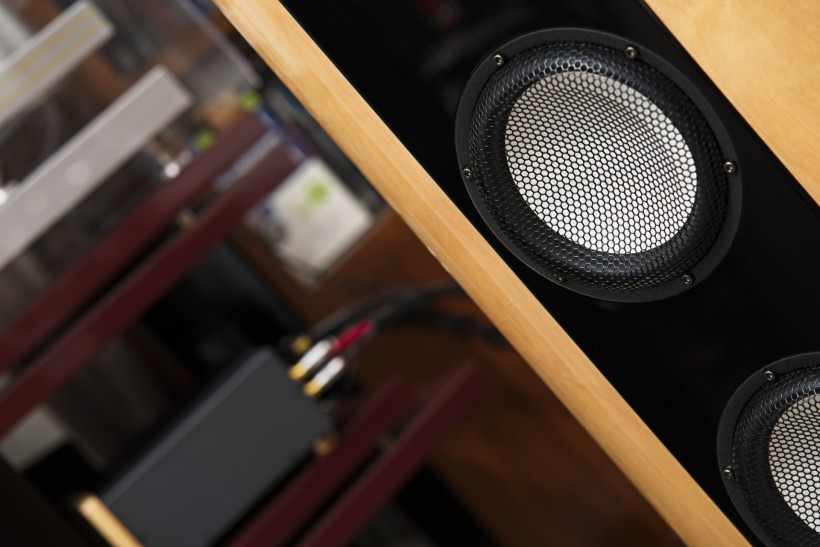
Design
As it reads on the manufacturer’s website, the cabinets of the reviewed speakers feature “cellular” design and are made of a new, optimized in terms of resonance, material – a plywood similar to that used for bodies of musical instruments. Most of the changes and innovations in comparison to older models are hidden inside those cabinets, but they themselves differ significantly from those used previously. They are relatively wide, feature convex front and rear baffles, which results from the general “elliptical” shape, in which however the side walls are concave for a change. The shapes of all the walls mean that they are not parallel, which prevents harmful standing waves inside the cabinets to appear. Thanks to the optimized “elliptical” shape it was also possible to use only minimal damping inside. The cabinets feature large, heavy bases with adjustable spikes. These bases protrude quite far beyond the outline of the cabinets, which increases stability of this fairly high design. The BlackHeron is quite a large loudspeaker measuring 116 cm in height, but due to the right proportions it does not become a dominant element in the room, although, thanks to the high class workmanship and finish quality it definitely can attract an eye. This is a 3.5-way system. All drivers feature ceramic membranes and, apart from the tweeter, the other three have the same diameter of 6.7 inches. Each of them is used to play a particular part of the band. The one placed lowest on the front baffle plays bass range, and the next two lower and upper midrange. It is a 4 Ω (nominal impedance) and 93 dB (sensitivity) design. Such parameters plus a special crossover circuit and a switch located on the back of each cabinet make BlackHeron perfect partners for a wide variety of amplifiers, both solid-state and tube ones, including low power SETs. The aforementioned switch is clearly described, and its operation, as Gerhard Hirt told me (without going into details) is not a simple linearization of impedance. When developing these special crossovers for the new models, Ayon team utilized all of its extensive experience and knowledge. As a result these elements largely determine the uniqueness of the new line of speakers. A single pair of high quality speaker terminals is placed on the back panel.
The BlackHeron is quite a large loudspeaker measuring 116 cm in height, but due to the right proportions it does not become a dominant element in the room, although, thanks to the high class workmanship and finish quality it definitely can attract an eye. This is a 3.5-way system. All drivers feature ceramic membranes and, apart from the tweeter, the other three have the same diameter of 6.7 inches. Each of them is used to play a particular part of the band. The one placed lowest on the front baffle plays bass range, and the next two lower and upper midrange. It is a 4 Ω (nominal impedance) and 93 dB (sensitivity) design. Such parameters plus a special crossover circuit and a switch located on the back of each cabinet make BlackHeron perfect partners for a wide variety of amplifiers, both solid-state and tube ones, including low power SETs. The aforementioned switch is clearly described, and its operation, as Gerhard Hirt told me (without going into details) is not a simple linearization of impedance. When developing these special crossovers for the new models, Ayon team utilized all of its extensive experience and knowledge. As a result these elements largely determine the uniqueness of the new line of speakers. A single pair of high quality speaker terminals is placed on the back panel.
Sound
Taking advantage of an opportunity to listen to the Kevlar prototype of Mr. Janusz Sikora’s tonearm (see review HERE), that debuted during the Audio Video Show 2018 in Warsaw, initially I listened to the Ayon loudspeakers with Crossfire amplifier and my turntable as a source. Only later, instead of the analogue source I started using CD35 HF and my LampizatOr Golden Atlantic as digital front end. Before getting to the sound description let me just shortly share my experience with placement of these speakers. At the beginning, I placed them in the same way as most speakers in my room, i.e. about 50-60cm from the wall behind them, slightly toed in. As it turned out, BlackHerons, however, prefer to have more space behind them – moving them by another 30cm away from the wall and toeing them slightly more in (since they were now placed closer to the listening place) offered better sonic results. First of all, there was a more compact, better defined bass, but also a slightly wider soundstage. I also liked better the more precise imaging and more natural tonal balance. I left Ayons positioned like that for most of my test. Just a few days before the end of the test dedicated quartz platforms for Ayon speakers were delivered by Nautilus. I have been using two similar Acoustic Revive platforms in my system for a few years now (under electronic devices). These Japanese products inspired Polish distributor to prepare similar ones, also for loudspeakers. My experience with these platforms has always been very positive so I had to try the ones prepared for BlackHeron too.
From the very beginning of the BlackHeron’s listening session, it was clear that their sound combines (apparently partly due to the amplifier and the source) seemingly contradictory features. On the one hand, I could hear the clarity, very good definition, speed, precision and transparency of the sound, or features that are usually attributed to ceramic drivers. On the other hand, however, the sound was also smooth, quite saturated, colorful and slightly, very slightly but still, warm. It was not warm in the sense as it is usually defined, nor artificially „warmed up”, but it definitely wasn’t cold or dry either, which happens more often than I like with ceramic driver based speakers. Sometimes the term “0+” is used in such cases to describe sound’s „temperature” and it fits here perfectly. That made me wonder how would these speakers sound like driven by a solid-state amp, as this sound signature was produced by BlackHeron paired with a SET. This particular one, Crossfire III, is definitely more neutral sounding than most, but still on a warm side of power. I decided to check it out later as the sound of Crossfire driving the BlackHeron was simply too interesting and too good to even bother to look for something else. Many (which does not mean that all) loudspeakers with ceramic drivers, I had a chance to listen to, delivered a very precise presentation, offering very sharp images, precisely defining each sound, but all those elements often lacked body, richness. That’s why for me (!) they often sounded dry, dispassionately, seemingly delivering a „correct” performance but somehow not really involving one, lacking in terms of emotions and musicality, or elements that are absolutely essential to me. Sure, there were some exceptions – I listened to Lumen White many times (usually with Ayon electronics) during various shows and these sounded great. Also Marten’s speakers belong to my favorites especially when driven with tube amplifiers (like at the last Audio Video Show, where they were paired with Engström monos). Also the older speaker models by Ayon paired with their own tube amplifiers did a very good job. It does not change the fact that in my opinion, these are more of exceptions to the rule than a feature that can be attributed to all speakers with ceramic drivers. It’s just that usually such designs do not belong to my personal favorites (which does not mean they are bad!).
Many (which does not mean that all) loudspeakers with ceramic drivers, I had a chance to listen to, delivered a very precise presentation, offering very sharp images, precisely defining each sound, but all those elements often lacked body, richness. That’s why for me (!) they often sounded dry, dispassionately, seemingly delivering a „correct” performance but somehow not really involving one, lacking in terms of emotions and musicality, or elements that are absolutely essential to me. Sure, there were some exceptions – I listened to Lumen White many times (usually with Ayon electronics) during various shows and these sounded great. Also Marten’s speakers belong to my favorites especially when driven with tube amplifiers (like at the last Audio Video Show, where they were paired with Engström monos). Also the older speaker models by Ayon paired with their own tube amplifiers did a very good job. It does not change the fact that in my opinion, these are more of exceptions to the rule than a feature that can be attributed to all speakers with ceramic drivers. It’s just that usually such designs do not belong to my personal favorites (which does not mean they are bad!).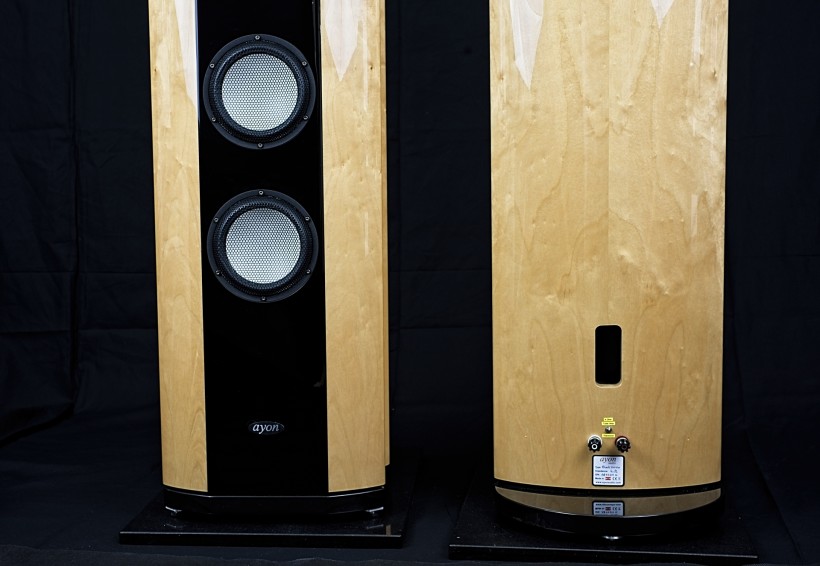 The new BlackHeron driven by Crossfire presented the definitely better (in my opinion) „side” of ceramic drivers. The great definition, precision, transparency and excellent differentiation were supported with richness, well rendered timbre of instruments, smoothness and beautiful flow of music. And when these features are combined in one presentation there is this magical term that comes to my mind first: “naturalness”. I am a music lover first and foremost and that is why the presentations simply must be natural. Everything starts and ends with this feature. What is this naturalness (I heard such a question several times) for me? The sound of instruments (mainly acoustic) and vocals should resemble that of live performances (preferably without any amplification) or be similar to the sound of my own guitar (not that I have any particular skills but I do know the sound of my instrument). Such natural presentation should make me forget about the sound and allow me to focus exclusively on music and emotions that are an inherent part of it. When listening to the music I should not have to wonder whether the sound of guitar, piano, bass, or sax is correct, but only about the performance of a great musician and its result – the MUSIC. Long story short – when the music starts to flow from the speakers and I automatically focus exclusively on it, not on the sound as such, it is the best possible symptom of the natural sound. However, I must point out that in case of the BlackHeron, naturalness and neutrality go hand in hand. As I have already mentioned, they do not offer a perfectly neutral sound and there is this delicate shift towards the warmer side that makes the sound so natural at the same time. It is a rare but very desirable combination of two seemingly mutually exclusive features that Ayon engineers have achieved with the BlackHeron.
The new BlackHeron driven by Crossfire presented the definitely better (in my opinion) „side” of ceramic drivers. The great definition, precision, transparency and excellent differentiation were supported with richness, well rendered timbre of instruments, smoothness and beautiful flow of music. And when these features are combined in one presentation there is this magical term that comes to my mind first: “naturalness”. I am a music lover first and foremost and that is why the presentations simply must be natural. Everything starts and ends with this feature. What is this naturalness (I heard such a question several times) for me? The sound of instruments (mainly acoustic) and vocals should resemble that of live performances (preferably without any amplification) or be similar to the sound of my own guitar (not that I have any particular skills but I do know the sound of my instrument). Such natural presentation should make me forget about the sound and allow me to focus exclusively on music and emotions that are an inherent part of it. When listening to the music I should not have to wonder whether the sound of guitar, piano, bass, or sax is correct, but only about the performance of a great musician and its result – the MUSIC. Long story short – when the music starts to flow from the speakers and I automatically focus exclusively on it, not on the sound as such, it is the best possible symptom of the natural sound. However, I must point out that in case of the BlackHeron, naturalness and neutrality go hand in hand. As I have already mentioned, they do not offer a perfectly neutral sound and there is this delicate shift towards the warmer side that makes the sound so natural at the same time. It is a rare but very desirable combination of two seemingly mutually exclusive features that Ayon engineers have achieved with the BlackHeron. 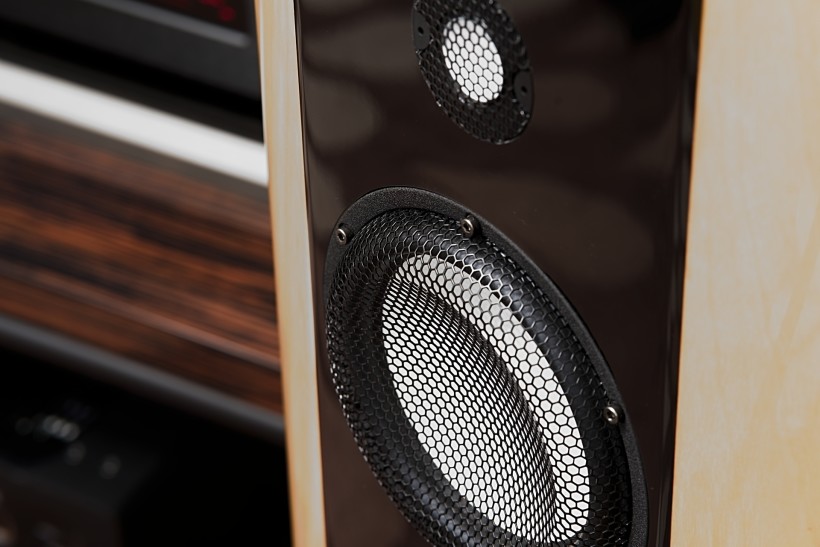 After spending several days listening to the Black Heron driven by the 30W Crossfire there was time to check out whether my 8W 300B SET would have enough power to drive them too. As it turned out, it depended a bit on a music genre. When I cued in the Tomasz Stańko’s „Suspended Night”, in a word rather subtle, calm, acoustic jazz, the sound was absolutely delicious. Rich, saturated, smooth, but with beautifully shown textures, with realistic, even though created in the studio, space with long, full reverbs. The master’s trumpet was slightly smoky or matte, but the metal cymbals shined and sparked. The piano and double bass sounded very good too, although … when they played the lowest notes it seemed that the definition was not as good as in the mid and upper bass range. Obviously it was not a question of speakers capabilities, but of a relatively small output of my SET. 30W from Crossfire was more than enough but 8W from 300B did not do as good job. Everything from, say, mid-bass up was excellent. The midrange was truly magical, as befits an amplifier with Western Electric 300Bs on board, smooth, colorful, palpable, with a wealth of information presented in an amazingly coherent and resolving way.
After spending several days listening to the Black Heron driven by the 30W Crossfire there was time to check out whether my 8W 300B SET would have enough power to drive them too. As it turned out, it depended a bit on a music genre. When I cued in the Tomasz Stańko’s „Suspended Night”, in a word rather subtle, calm, acoustic jazz, the sound was absolutely delicious. Rich, saturated, smooth, but with beautifully shown textures, with realistic, even though created in the studio, space with long, full reverbs. The master’s trumpet was slightly smoky or matte, but the metal cymbals shined and sparked. The piano and double bass sounded very good too, although … when they played the lowest notes it seemed that the definition was not as good as in the mid and upper bass range. Obviously it was not a question of speakers capabilities, but of a relatively small output of my SET. 30W from Crossfire was more than enough but 8W from 300B did not do as good job. Everything from, say, mid-bass up was excellent. The midrange was truly magical, as befits an amplifier with Western Electric 300Bs on board, smooth, colorful, palpable, with a wealth of information presented in an amazingly coherent and resolving way.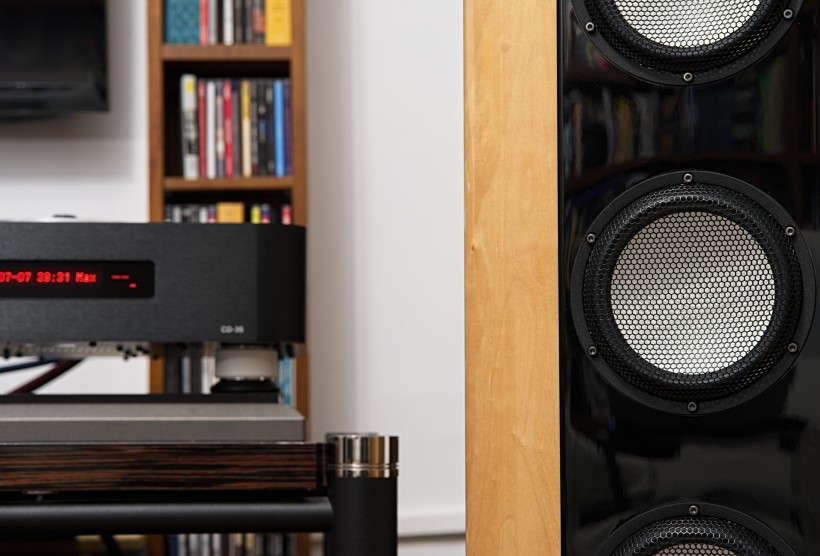 It was a very present, three-dimensional presentation, with musicians placed (almost) within my reach, with an amazingly immersive ambiance. At the top of the range, delicacy and smoothness combined perfectly with sonority and energy. The drums in most recordings sounded fantastic – fast, taut, well-differentiated. And only the very lowest notes sometimes got a bit boomy due to the lack of sufficient control especially when it came to a bit more complex and more demanding, low-bass-rich music. Among many high-efficiency speakers I listened to, the BlackHerons, although really good, might not be the best possible partners for a low-power SET amplifier, although it should definitely be considered case-by-case depending on preferred music, room size and volume levels. The 30W Ayon Crossfire III’s output was already enough to perfectly drive and control the BlackHeron no matter how complex music I listened to. The 8W in most cases worked great but in few were not enough. I guess that doubling the power of a 300B SET (so say a solid 15W) would already do a trick with these speakers. This, however, is only my speculation. Of course, even with a single 300B per channel in a not too big room (24 sqm and bit over 3m in height in my case), in a calm repertoire or in any other but at moderate volume levels, the BlackHerons created an immersive, spatial, tuneful, resolving musical spectacle that I loved. And some minor symptoms of the lack of absolute control over the woofers were absolutely acceptable – there are no perfect solutions in audio, there are always pros and cons. I think that the cons in this case are easily acceptable simply because advantages of combining the BlackHeron with a 300B SET can win a lot of music lovers hearts.
It was a very present, three-dimensional presentation, with musicians placed (almost) within my reach, with an amazingly immersive ambiance. At the top of the range, delicacy and smoothness combined perfectly with sonority and energy. The drums in most recordings sounded fantastic – fast, taut, well-differentiated. And only the very lowest notes sometimes got a bit boomy due to the lack of sufficient control especially when it came to a bit more complex and more demanding, low-bass-rich music. Among many high-efficiency speakers I listened to, the BlackHerons, although really good, might not be the best possible partners for a low-power SET amplifier, although it should definitely be considered case-by-case depending on preferred music, room size and volume levels. The 30W Ayon Crossfire III’s output was already enough to perfectly drive and control the BlackHeron no matter how complex music I listened to. The 8W in most cases worked great but in few were not enough. I guess that doubling the power of a 300B SET (so say a solid 15W) would already do a trick with these speakers. This, however, is only my speculation. Of course, even with a single 300B per channel in a not too big room (24 sqm and bit over 3m in height in my case), in a calm repertoire or in any other but at moderate volume levels, the BlackHerons created an immersive, spatial, tuneful, resolving musical spectacle that I loved. And some minor symptoms of the lack of absolute control over the woofers were absolutely acceptable – there are no perfect solutions in audio, there are always pros and cons. I think that the cons in this case are easily acceptable simply because advantages of combining the BlackHeron with a 300B SET can win a lot of music lovers hearts. 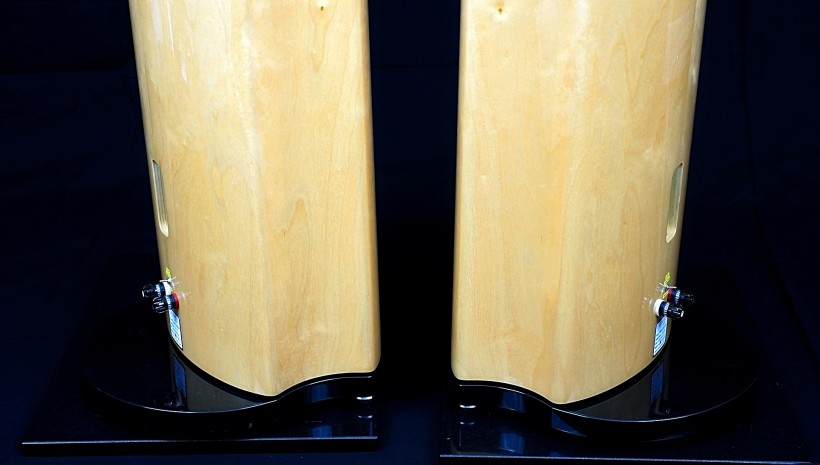 After the adventure with my 300B SET, it was time to listen to the BlackHeron paired with solid-states at hand. I began with my GrandiNote Shinai capable of delivering 37W per channel in class A. At first this setup sounded very … tube-like, but more like a stereotype tube amplifier than a high quality one. The Italian company uses a proprietary solution that is called “Magnetosolid”. Max Magri, boss and chief designer of the brand, emphasizes that although this is a transistor design, the circuit is very similar to those used in tube amplifiers. And it shows a little in the sound, but usually as a combination of the best tube features with lot of advantages of solid-state design. Never before has the integrated sounded so “tube-ish” like in this case, paired with the Ayon BlackHeron. The sound was warm, even sweet, fluid, in a word very pleasant, but I expected something else, something more, a lot more actually. As for a performance of a system driven by transistor amplifier it was too sweet, not as pure and transparent as I expected, and timing was also not as perfect as it should have been. Stańko still sounded very nice, pleasant but it seemed to me that the trumpet was more dull than with the 300B, “softer”, and the same was happening in the bass range. The cymbals were sonorous, but not as open, as airy sounding as I knew them to be from experience with this amplifier driving other speakers, or as expected from ceramic drivers. It took me some time before I realized why (although the fact that I kept listening for so long proved that it was still a nice sound after all) it was happening. Namely, I realized that I left the the flip switch on the back of the speakers in the “tube” position, even though I switched to solid-state amp.
After the adventure with my 300B SET, it was time to listen to the BlackHeron paired with solid-states at hand. I began with my GrandiNote Shinai capable of delivering 37W per channel in class A. At first this setup sounded very … tube-like, but more like a stereotype tube amplifier than a high quality one. The Italian company uses a proprietary solution that is called “Magnetosolid”. Max Magri, boss and chief designer of the brand, emphasizes that although this is a transistor design, the circuit is very similar to those used in tube amplifiers. And it shows a little in the sound, but usually as a combination of the best tube features with lot of advantages of solid-state design. Never before has the integrated sounded so “tube-ish” like in this case, paired with the Ayon BlackHeron. The sound was warm, even sweet, fluid, in a word very pleasant, but I expected something else, something more, a lot more actually. As for a performance of a system driven by transistor amplifier it was too sweet, not as pure and transparent as I expected, and timing was also not as perfect as it should have been. Stańko still sounded very nice, pleasant but it seemed to me that the trumpet was more dull than with the 300B, “softer”, and the same was happening in the bass range. The cymbals were sonorous, but not as open, as airy sounding as I knew them to be from experience with this amplifier driving other speakers, or as expected from ceramic drivers. It took me some time before I realized why (although the fact that I kept listening for so long proved that it was still a nice sound after all) it was happening. Namely, I realized that I left the the flip switch on the back of the speakers in the “tube” position, even though I switched to solid-state amp.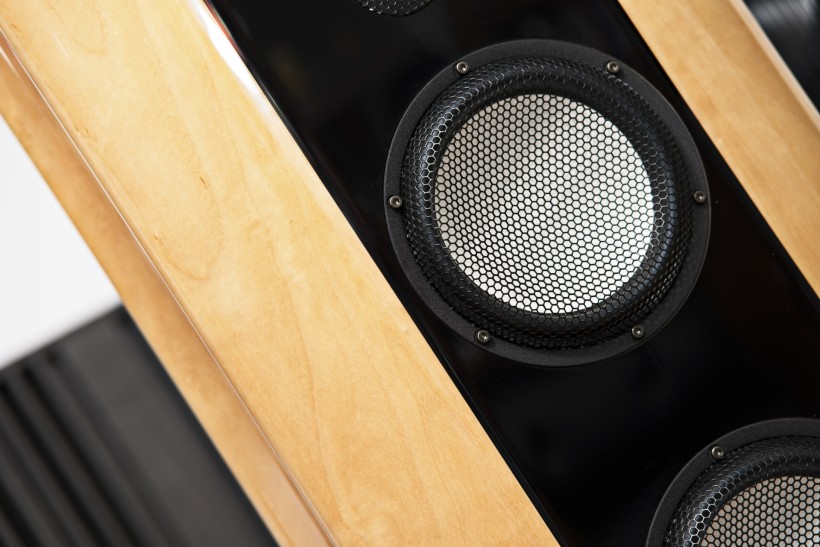 I stopped the playback, flipped switches in both speakers to the correct position. I returned to my chair, pressed “Play” on the remote and … it immediately became clear that this optimization of the loudspeakers’ crossovers in terms of the type of amplifier driving them is by no means just a marketing catchphrase. The sound opened, the treble gained in its (natural) splendor, finally there were sparks there that before were rapidly extinguished, the sound wasn’t so sweet anymore and the expected purity and precision returned. It was even clearer with the next album, the Ronny Jordan’s „At Last”. The kick drum became fast, taut, well… „kicking”, the bass guitar was very well-differentiated, powerful, energetic, drummers timing was impeccable and Ronny’s electric guitar finally sounded the way it was supposed to. The PRAT was so good that my feet started to tap the rhythm and I had my share of fun with this recording. There was less of the tube’s „ethereal character” of the Crossfire, or even more so of the Symphony II, it was not as convincingly three-dimensional and tangible as with tubes, but the difference in these respects wasn’t that big while the gain in terms of energy of the performance, drive and dynamics of sound was definitely worth considering (while choosing between tube and solid-state partner for the reviewed speakers). As a SET fan, I would be inclined to pairing them with Ayon’s own tube amp, but I would be happy with Shinai-driven BlackHeron as well. There were no obvious flaws here, and only when analyzing the sound (instead of listening to the music) I realized that some elements of the sound could have been presented in an even better way. Although, probably not with any transistor amp, because in terms of tangibility, imaging, spacing and naturalness of sound, good tubes always deliver better performance than any solid-state. Even as good one as the Shinai.
I stopped the playback, flipped switches in both speakers to the correct position. I returned to my chair, pressed “Play” on the remote and … it immediately became clear that this optimization of the loudspeakers’ crossovers in terms of the type of amplifier driving them is by no means just a marketing catchphrase. The sound opened, the treble gained in its (natural) splendor, finally there were sparks there that before were rapidly extinguished, the sound wasn’t so sweet anymore and the expected purity and precision returned. It was even clearer with the next album, the Ronny Jordan’s „At Last”. The kick drum became fast, taut, well… „kicking”, the bass guitar was very well-differentiated, powerful, energetic, drummers timing was impeccable and Ronny’s electric guitar finally sounded the way it was supposed to. The PRAT was so good that my feet started to tap the rhythm and I had my share of fun with this recording. There was less of the tube’s „ethereal character” of the Crossfire, or even more so of the Symphony II, it was not as convincingly three-dimensional and tangible as with tubes, but the difference in these respects wasn’t that big while the gain in terms of energy of the performance, drive and dynamics of sound was definitely worth considering (while choosing between tube and solid-state partner for the reviewed speakers). As a SET fan, I would be inclined to pairing them with Ayon’s own tube amp, but I would be happy with Shinai-driven BlackHeron as well. There were no obvious flaws here, and only when analyzing the sound (instead of listening to the music) I realized that some elements of the sound could have been presented in an even better way. Although, probably not with any transistor amp, because in terms of tangibility, imaging, spacing and naturalness of sound, good tubes always deliver better performance than any solid-state. Even as good one as the Shinai. I left another, more powerful transistor for last. It was a design by Conrad Mos, whose brand, Avid, is synonymous with turntables, but in recent years we have seen also loudspeakers and amplifiers developed by them. The Sigsum is the latest integrated capable of delivering 110W output to 8Ω loading (the manufacturer does not state the output for 4Ω) – in a word, it’s a pretty powerful contender. In this setup (with the transistor / tubes switches in the right position), the sound shifted towards the tonal neutrality. In the direction of precision, transparency, perfect control and definition of each sound and even better timing. I think that this features list would be the most convincing for the fans of the “high fidelity”. The CD35 HF, despite the tube output stage, belongs to highly „fidele” or very accurate players capable of delivering top quality sound. Combined with Sigsum, they presented a very pure, but saturated, extremely rich with information, details and subtleties signal to the BlackHerons. And although, as I have already mentioned, it was the most neutral, the most transparent and the most analytical (fortunately without exaggeration) performance I experienced with these speakers, this particular set of features did not cause the naturalness of sound, musicality or the saturation of the presentation with emotions to disappear. The sound was not as rich and as fluid as with both SETs or the Class A solid-state, but I did enjoy my favorite music with it, just in a different way. The focus was still on music not the sound, although it was presented in a slightly different, slightly less tangible, less present way than before. But on the other hand, in a more precise way, offering a better insight into the recordings and differentiating them even better. This proved how little the BlackHerons have of their own sonic signature and how much the final sonic result depends on the system that drives them.
I left another, more powerful transistor for last. It was a design by Conrad Mos, whose brand, Avid, is synonymous with turntables, but in recent years we have seen also loudspeakers and amplifiers developed by them. The Sigsum is the latest integrated capable of delivering 110W output to 8Ω loading (the manufacturer does not state the output for 4Ω) – in a word, it’s a pretty powerful contender. In this setup (with the transistor / tubes switches in the right position), the sound shifted towards the tonal neutrality. In the direction of precision, transparency, perfect control and definition of each sound and even better timing. I think that this features list would be the most convincing for the fans of the “high fidelity”. The CD35 HF, despite the tube output stage, belongs to highly „fidele” or very accurate players capable of delivering top quality sound. Combined with Sigsum, they presented a very pure, but saturated, extremely rich with information, details and subtleties signal to the BlackHerons. And although, as I have already mentioned, it was the most neutral, the most transparent and the most analytical (fortunately without exaggeration) performance I experienced with these speakers, this particular set of features did not cause the naturalness of sound, musicality or the saturation of the presentation with emotions to disappear. The sound was not as rich and as fluid as with both SETs or the Class A solid-state, but I did enjoy my favorite music with it, just in a different way. The focus was still on music not the sound, although it was presented in a slightly different, slightly less tangible, less present way than before. But on the other hand, in a more precise way, offering a better insight into the recordings and differentiating them even better. This proved how little the BlackHerons have of their own sonic signature and how much the final sonic result depends on the system that drives them.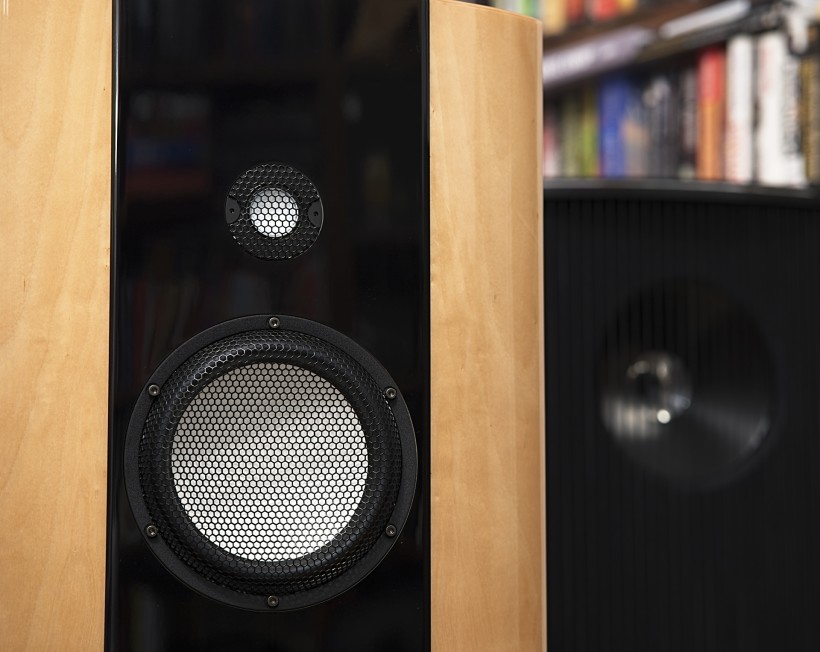 A few days before the end of the test, I was provided with an upgrade proposed by the Polish distributor, i.e. the quartz platforms. My Acoustic Revive ones do a great job used under various electronic devices – I place sources, preamplifiers and amplifiers on top of them and the influence is always positive, but the scope of sound improvement varies. So far I have not used them (if I remember correctly) under any loudspeakers. The BlackHeron case proved however that it was worth trying. It was not about changing the sonic signature, or in any large, significant differences at all. Rather, in small, but noticeable ones, such as a bit better separation, even more internal coherence or order if you will (not that I’d had even the slightest reservations in this respect without these platforms, but with them sound just got even better), even greater clarity and differentiation in all sub-ranges. All these were slight changes, barely noticeable themselves, but combined they introduced improvement big enough so that when, after listening to this configuration throughout the whole day, I removed platforms from under the speakers, I immediately noticed that something was missing in the sound. It was still very good but the knowledge it could be even better, maybe by a small margin but still, bothered me. I admit that I did not even ask how much these platforms cost, but I suspect that compared to the price of loudspeakers they would be an acceptable additional cost. They do improve sound and they look cool – one should definitely give them a try.
A few days before the end of the test, I was provided with an upgrade proposed by the Polish distributor, i.e. the quartz platforms. My Acoustic Revive ones do a great job used under various electronic devices – I place sources, preamplifiers and amplifiers on top of them and the influence is always positive, but the scope of sound improvement varies. So far I have not used them (if I remember correctly) under any loudspeakers. The BlackHeron case proved however that it was worth trying. It was not about changing the sonic signature, or in any large, significant differences at all. Rather, in small, but noticeable ones, such as a bit better separation, even more internal coherence or order if you will (not that I’d had even the slightest reservations in this respect without these platforms, but with them sound just got even better), even greater clarity and differentiation in all sub-ranges. All these were slight changes, barely noticeable themselves, but combined they introduced improvement big enough so that when, after listening to this configuration throughout the whole day, I removed platforms from under the speakers, I immediately noticed that something was missing in the sound. It was still very good but the knowledge it could be even better, maybe by a small margin but still, bothered me. I admit that I did not even ask how much these platforms cost, but I suspect that compared to the price of loudspeakers they would be an acceptable additional cost. They do improve sound and they look cool – one should definitely give them a try.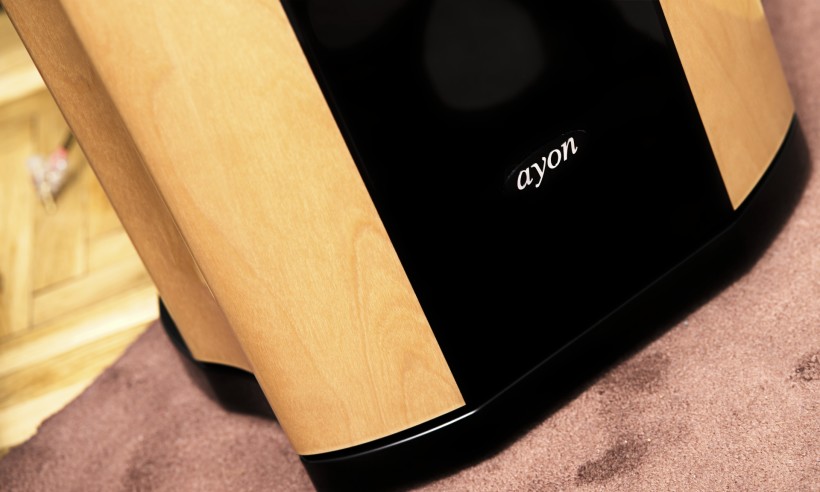
Summary
Ayon Audio BlackHeron are one of the most versatile loudspeakers I know. In this respect, they resemble my GrandiNote MACH4, although in terms of looks, or of design as such, they differ significantly. This versatility is only a bonus from customer’s perspective, but an important one. There are not many audiophiles who live with one system for many years. Usually, sooner or later, our “audiofilia nervosa” comes out and as a result, whether we really need it or not, we do purchase a new amplifier, source, cables or speakers. For those who should get BlackHeron for their systems, loudspeakers will probably be the last component to be replaced in the future. First of all, they are excellent performers. They offer a clean, transparent, resolving and dynamic performance, that at the same time is also smooth, coherent and natural. They create an impressive soundstage, large, tangible phantom images and impress with openness of the sound. And they offer all that effortlessly with virtually every music genre, driven by any type of (high quality) amplifier. They also let the latter decide the ultimate sonic signature of the whole system. Due to the unique crossovers’ design and a simple switch on their backs, they will perform equally well with a powerful solid-state and with SET. Let’s add to this fantastic performance and unique versatility a matching highest quality make and finish and what we get is a product that will please both, our ears and eyes. And it will most likely stay in the system for many years, because it will easily adapt to any changes one may come up with. Don’t take my word on it, simply give them a try.
Technical specification (according to manufacturer):
- System: 3.5-way, AirFlow Damping System (ADS)
- Cabinet design: elliptic
- Cabinet material: resonance optimized instrument plywood
- Driver compliment: 1 x 1.2″ Cell-Ceramic Tweeter; 1 x 6.7″ Ceramic Woofer/Upper-Mid; 1 x 6.7″ Ceramic Woofer/Lower-Mid;
1 x 6.7″ Ceramic Woofer - Crossover frequencies: 180 Hz / 400 Hz / 1000 Hz / 2500 Hz
- Impedance: 4 Ω
- Sensitivity (1W / 1m): 93 dB
- Recommended amp power: 5 – 120 W
- Frequency response: 34 Hz – 30 kHz / – 3 dB
- Speaker terminals: WBT NextGen
- Internal wire: custom made
- Dimensions (HxWxD): 116x36x25 cm
- Weight (a piece): 38 kg
Price (when reviewed):
- Ayon Audio BlackHeron: 18.900 EUR
Manufacturer: AYON AUDIO
Distributor: NAUTILUS
Associated equipment:
- Analogue front end: J.Sikora Basic MAX turntable, J.Sikora KV12 tonearm , AirTight PC-3, phonostages: Grandinote Celio mk IV, ESE Lab Nibiru V 2.5
- Digital source: a passive, custom PC with WIN10, Roon, Fidelizer Pro 7.3, JCat USB Femto card with iFi power supply, Hdplex linear power supply for PC, JCAT USB Isolator
- D/A Converter: LampizatOr Golden Atlantic +Ideon Audio 3R Master Time (USB signal regenerator)
- CD / SACD Player: Ayon Audio CD 35 HF
- Power amplifier: GrandiNote Shinai, ArtAudio Symphony II (modified), Ayon Audio Crossfire III, AVID SigSum
- Preamplifier: Audia Flight FLS1
- Loudspeakers: Ubiq Audio Model ONE Duelund Edition. GrandiNote MACH4
- Interconnects: Hijiri Million (RCA), Less Loss Anchorwave (RCA), KBL Sound Zodiac XLR, TelluriumQ Silver Diamond USB
- Speaker cables: LessLoss Anchorwave
- Power cables: LessLoss DFPC Signature, Gigawatt LC-3
- Power:Gigawatt PF-2 MK2 and Gigawatt PC-3 SE Evo+; a dedicated power line with Gigawatt LC-Y in-wall cable; Gigawatt G-044 Schuko and Furutech FT-SWS-D (R)
- Racks: Base VI, Rogoz Audio 3RP3/BBS
- Anti-vibration accessories: ROGOZ-AUDIO SMO40 and CPPB16 platforms and ROGOZ AUDIO BW40MKII feet, Franc Accessories Ceramic Disc Slim Feet and Wood Block Platform



